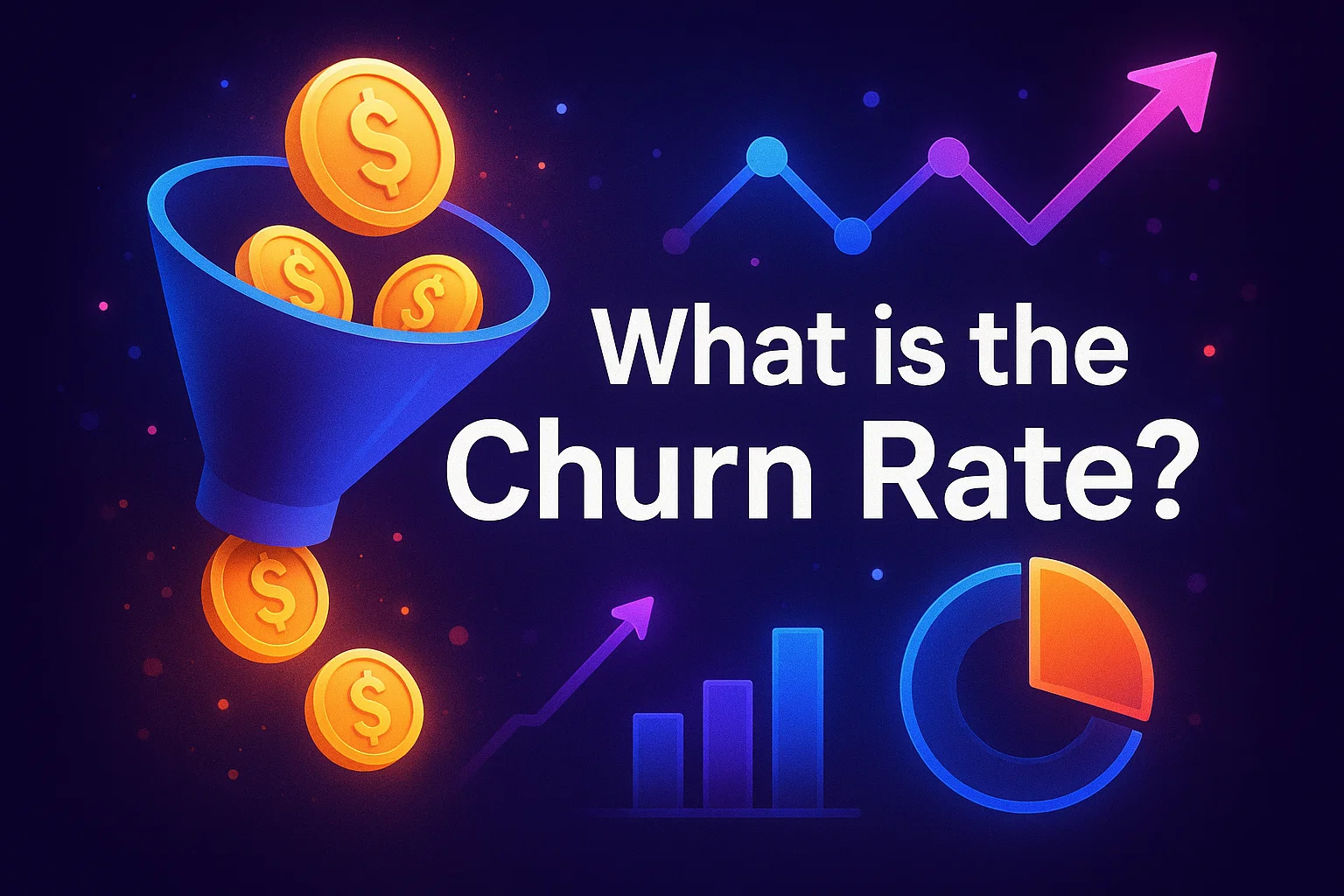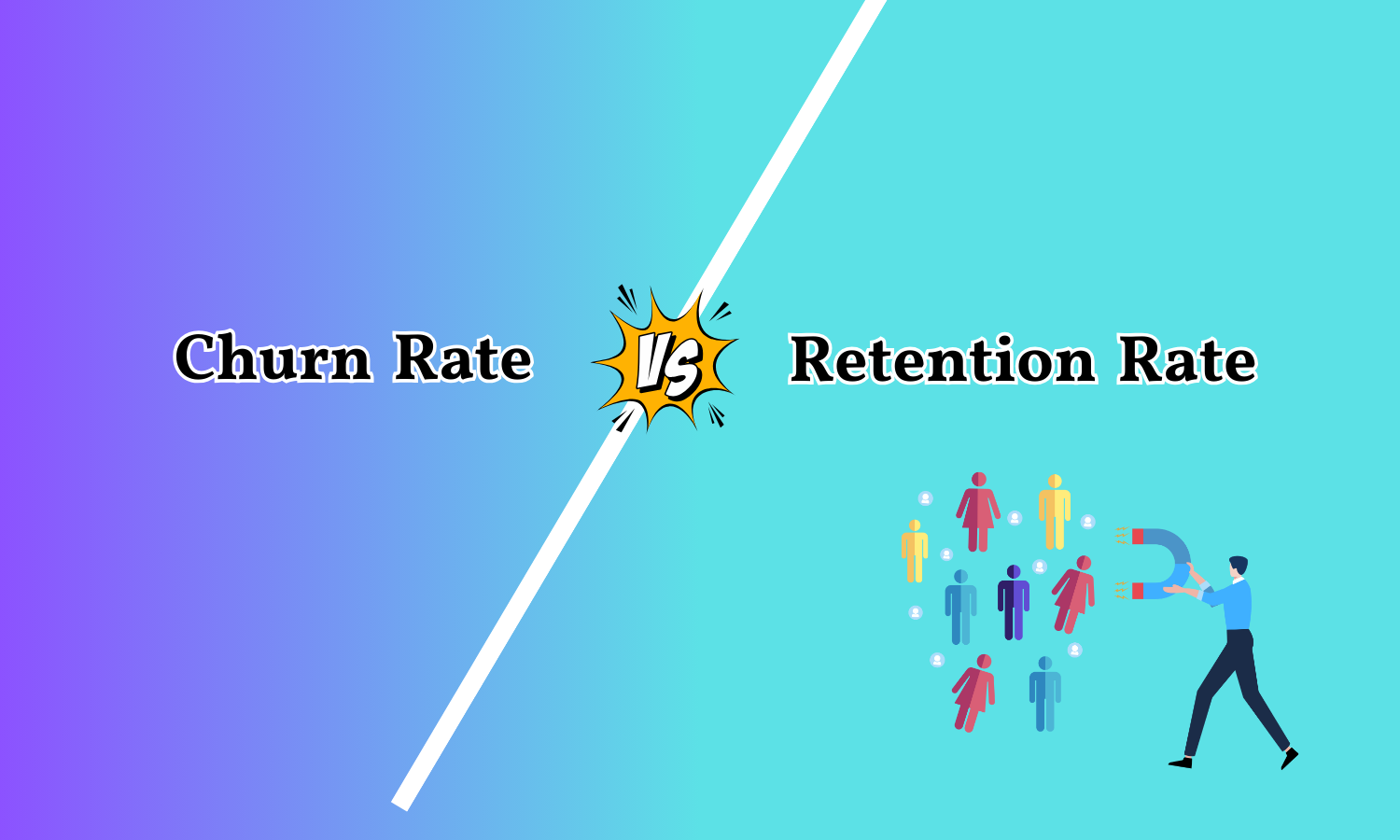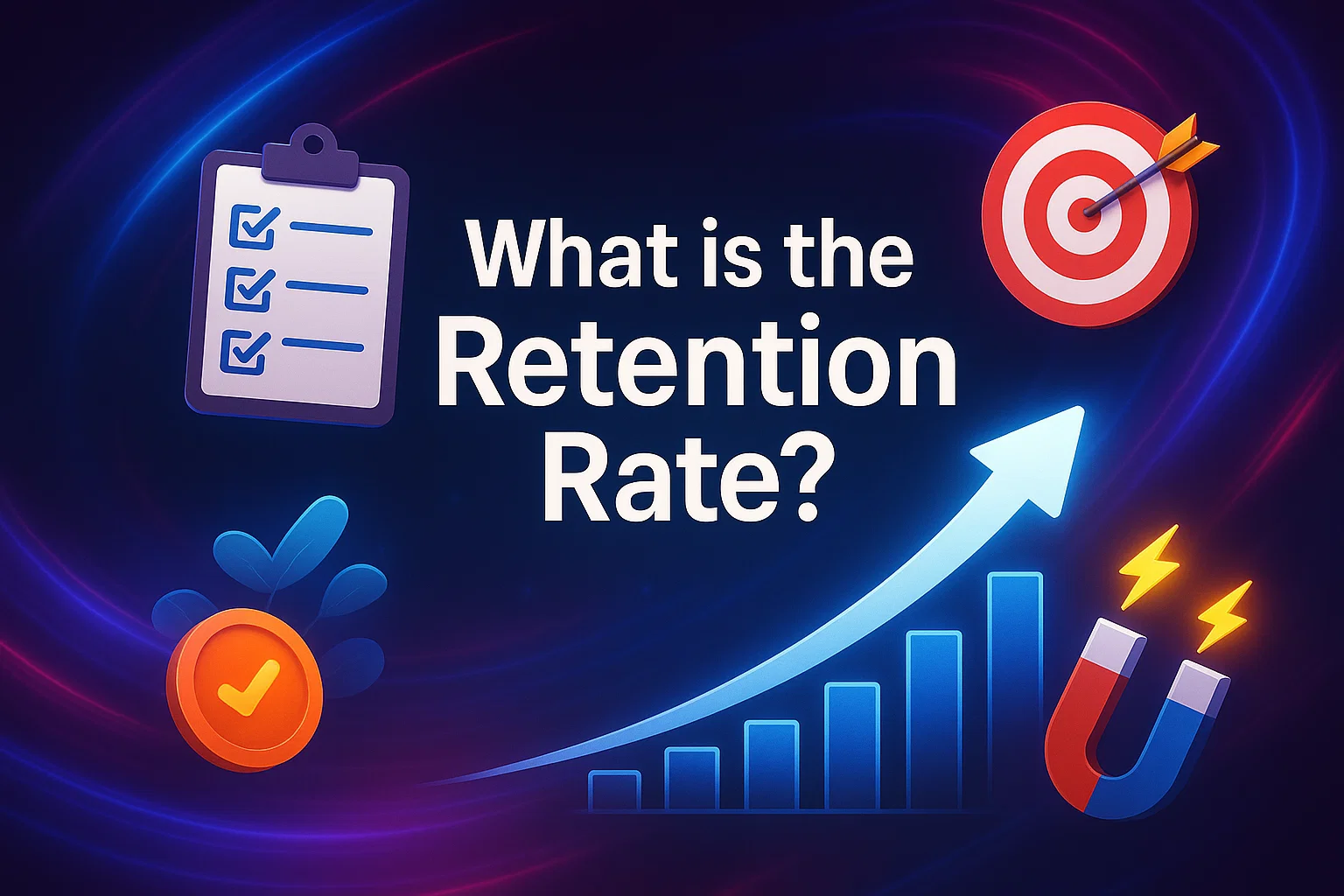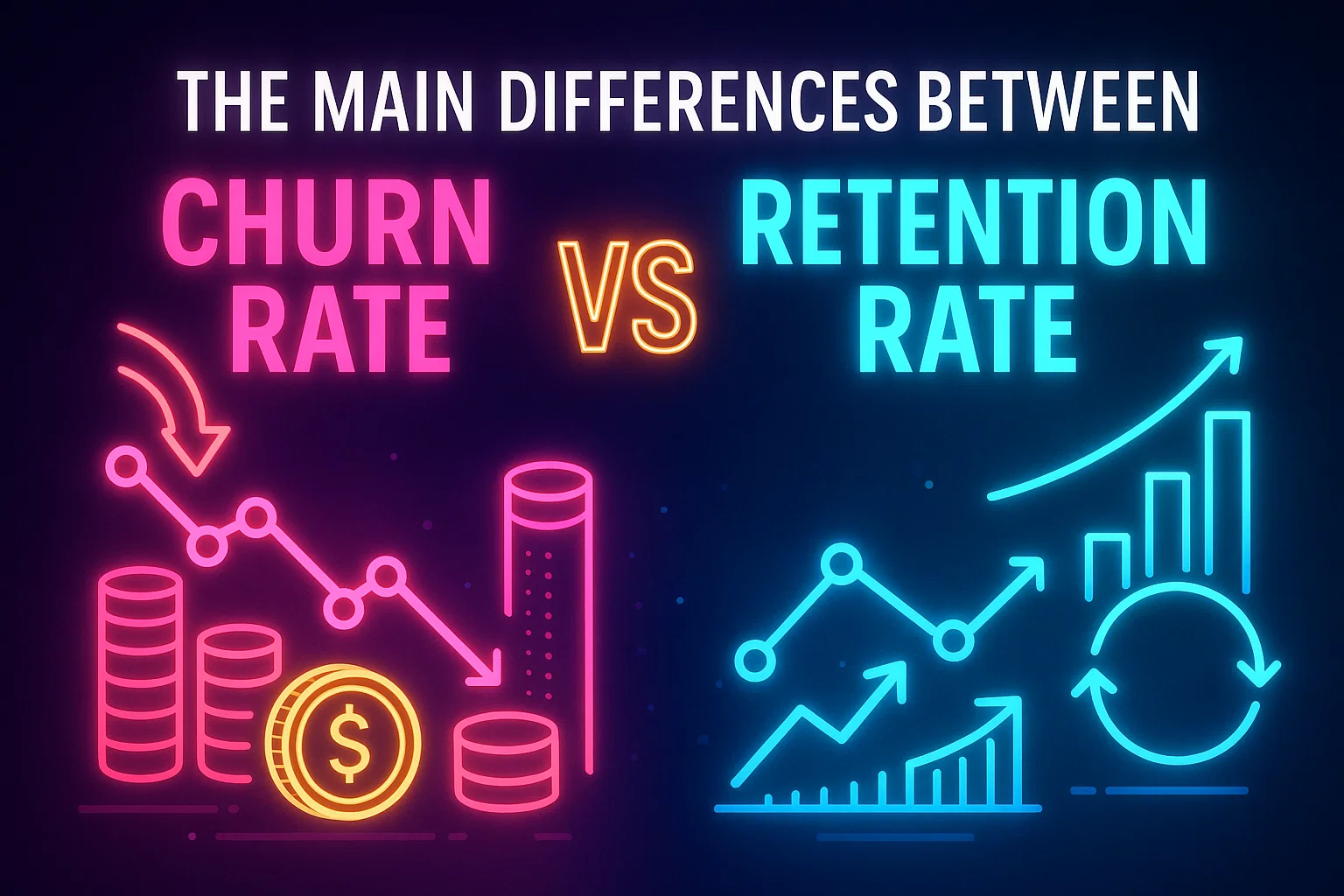The churn rate is the percentage of customers who leave, whereas the retention rate shows the percentage of customers that continue with you over a specific timeframe.
You can assume it is like a subscriber cancels their Netflix account as they might be unhappy with the content library due to being costly or find the best at a competitor like Disney+. This is a churn. Now that any subscriber continues to pay their monthly fee to enjoy the streaming service, it is retention.
Both are important KPIs from which you will get valuable insights into customer satisfaction levels for a business. Though they are used to track user behavior, they have noticeable differences in various aspects.

What is the churn rate?
The churn rate represents the number of individuals who have left the group over a given period. Sometimes, the term is used as attrition rate, which applies in various industries including business, telecommunications, SaaS, retail, banking, and insurance.
In business, customer churn rate is one of the key indicators that measure the rate at which customers have left the brand and stopped using their services. It is just the opposite term of growth rate and the most concerning factor for businesses in their revenue generation.
A higher churn rate is more likely a red flag for the business that tells a large portion of their customers have switched to another provider for some reason. However, what churn rate is good or bad for the business varies from industry to industry.
How to Calculate Churn Rate?
The churn rate is simple but an important indicator to find out the customer experience key performance. Here is this simple formula to figure out the churn rate of a business:
Churn rate= (The number of lost customers during a period/ total number of customers at the beginning of the period of business)*100
Assume you have been running a subscription-based online business for one year. Now you have decided to check your customer churn rate. At the starting period of your business, you had 500 new customers. With the year ending, you have seen that unfortunately, 25 customers have canceled their subscriptions.
Now, simply divide your lost customer number with the customer numbers you have at the beginning of your business.
- Churn Rate = (25 / 500) * 100
Or, 5%
It means you have lost 5% of customers from your business throughout the year.
What is the Retention Rate?
Retention rate is the percentage of satisfied customers or employees who remain with a company o for a long time. It’s an important metric, especially for subscription-based businesses that help understand how they are retaining customers.
Often, these companies have to find out whether their features or services meet their customers’ needs. For that, it is needed to figure out the retaining customers over time. With the customer retention rate, businesses easily track their new customer numbers regardless of whether they improved their review stream.
How to Calculate Retention Rate?
Retention rate is an effective KPI through which businesses can find out the key areas of improvement to keep the existing customers engaged. You can even easily figure out your company’s retention rate by the formula below:
(Total number of customers you have at the end of the month – the number of customers you have acquired over that time) = The number of customers retained
Now use the calculation of new customers and find out the retention rate as follows:
Customer Retention Rate = ( Retained customers number / Total number of customers at the start of the month) * 100
Example: You have been running a fitness gym for one month. At the first of the month, you had 200 members. However, due to your great service and promotion, an additional 60 members have joined your gym center. Now you have calculated and found 250 members in total.
Calculate the number of members retained:
- Total members by the end of the month = 250
- New members acquired = 60
- Members retained = 250 – 60 = 190
Now find the customer retention rate:
(190 / 200) * 100 = 95%
It means you have about 95% of customers who have continued with the company over the month.
The Main Differences Between Churn Rate and Retention Rate
The difference between a business’s churn and retention rate mainly lies in the distinct customer data points they measure-
The churn rate measures the percentage of customers who stop continuing with a company at a certain period the retention rate shows how many customers are being loyal to the company after a certain time.
A company can easily compare its new subscribers or customers to how many ones have stopped at the same point to determine both its churn rate and retention rate. This overall gives clear insights into a business’s growth or loss in a specific period.
For example:
A company, Cloudsuit, offers cloud-based project management software. Over about 3 months, the company has gained 100 new subscribers due to a subscribed marketing campaign or introduction to new features. However, at the same time, it has lost about 120 customers who canceled their subscriptions with the company. It could be due to various reasons. Let’s say poor customer service or found more affordable and innovative options in the competitors.
This overall means the company has lost more customers than it gained, with a net loss of about 20 subscribers. As the company has lost more than gained, it should have a positive impact on the churn rate and a negative impact on the retention rate. The churn rate of the company will get higher, and the retention rate will decrease to about 45%.
So, it is important to maintain a higher retention rate in the company than its churn rate, as it directly impacts revenue growth. The rising churn rate defines the existing subscribers who continue to leave the company, which makes it harder to get sustainable growth.
For example, a company with a 90% retention rate is more likely to experience steady revenue growth as its existing subscribers are ensuring a solid foundation of income by staying long-term with it. On the other hand, if a company has only about a 20% churn rate, even if the company gains new customers, the cost of acquiring them will reduce overall profit. It negates the impact of this revenue as it continually enters the cycle of replacement rather than growth.
Major Differences Between Churn Rate and Retention Rate
Here we have highlighted the difference between the churn rate and retention rate in different aspects. Have a look:
1. SaaS Sales
In SaaS business, the churn rate is the measurement at which customers cancel the subscription or stop continuing with the product over a specific timeframe. On the contrary, the retention rate will help you find satisfied customers who are willing to pay for the products and continue with the service.
For example, Applyoee, the most renowned SaaS company that offers online time-tracking software, has a churn rate of 30% with only 20% retention. It means a good number of customers are not satisfied with the product or service. It could be due to various reasons, like:
- Bad onboarding
- Lack of long-term customer success
- Poor customer support
- Product or service doesn’t hit the customer goals
- Inadequate product updates or innovation
Besides, a higher retention rate ensures your company’s growth. According to Harvard Business Review, only a 5% increase in customer retention ensures up to a 25% growth in profit. Overall, Both of the customer metrics have important roles in the SaaS business, especially to determine a company’s health.
2. Customer Lifetime Value
CLV is the most common metric used in the study that measures the total revenue a business can expect from a customer throughout their lifetime engagement. Churn rate has a high impact on this measure, with an estimated about $1.6 trillion in revenue lost yearly.
A higher churn rate reduces your business CLV while the rate exceptionally increases with the rising retention rate. That means they are positively correlated. When one is going up, so the other one is.
3. Customer Acquisition Costs
Customer acquisition cost is the amount of money the company spends to win a newer customer. It includes costs related to marketing and sales efforts to get the customers. However, the churn rate and retention of the business highly influence the acquisition cost of the company.
If the churn rate is higher or at a decent scale, it decreases the acquisition cost. That means the company’s customer service and marketing efforts are enough to keep existing ones engaged and making repeat purchases. Besides, businesses don’t need to spend a lot on acquiring new customers.
For example, a company spends about $80 on a marketing campaign and gets new subscribers who pay up to $40 each month. If he stays for 6 months, you make $240 from them. Since they stay long, the company doesn’t have to spend extra to replace them and reduces the CAC.
On the other side, the churn rate just increases the customer acquisition cost. A higher churn rate means the company needs to spend a lot more on marketing and sales to instantly get new customers and replace the lost ones.
For instance, a company’s churn rate is 10% in a month and it spends up to $100 to have new customers. If the churn rate increases to 20%, it would require 20 new customers each month to keep their customer base, which doubles the acquisition cost.
4. Ideal Goals
Though it is always best to aim for a 0% churn rate and a 100% retention rate for maximum return on investment, it often seems challenging. Plus, the good balance for the churn rate and retention will vary depending on various platforms. Have a look and get an instant idea.
i) SaaS
The SaaS model is designed to constantly retain customers. However, due to some lacking over time, it also faces delays in user retention and that leads to a good churn rate. Still, the ideal churn rate for SaaS should be between 3 and 8% for sustainable company growth.
On the other hand, it is best to ensure the retention rate of a SaaS company is 90%, though various established SaaS businesses aim for as high as 97%. The average customer retention rate in SaaS across industries is approximately 68%
ii) Software Development and IT
The churn rate for the IT company should not fall below 2%, and it should be between 3-5% for enterprises and 5-7% for small SaaS companies. If the company is targeting and marketing, the churn rate between 2.5% and 5% is good, whereas less than 1.5% would be best.
However, the average retention rates in the IT sector are significantly higher, at about 81% due to ongoing services on clients’ focus.
iii) Marketing and Advertising
In the marketing and advertising industry, it is easy to have 5% and 7% churn, and established companies even experience a lower churn rate than that. Besides, companies with good marketing strategies enjoy retention rates up to 84%, with the average in the industry around 70-80%
Strategies to Reduce Churn & Improve Retention
Companies should work on improving the retention rate along with lowering the churn rate as much as possible. Focusing on improving the retention rate is even far more events.
According to the report, acquiring new customers is about 5 times more expensive than retaining existing ones. Plus, by reducing the churn rate, you can save a lot on acquisition costs.
However, here are some helpful tips to maintain a good balance between these two metrics and ensure long-term business success:
Improve Customer Experience
Customer experience has a direct impact on the retention rate and churn rate of the business. According to the latest report, about 86% of customers are willing to pay more for services or products with great customer experience. In contrast, up to 9-10% just leave a company due to poor service from the company. So, you must focus on what the customer expects and do much better than that.
Offer Personalised Communication
To build a strong relationship, strong customer communication is more likely a key. With personalized communication, your business not only builds trust with them but also effectively addresses their concerning factors. It helps you offer products or solutions specific to them and saves them from frustration and misunderstandings about your business. This way, you can stop losing customers and increase the retention rate.
Implement Loyalty Programs
Loyalty programs are the most effective strategies to retain customers. This is like you are rewarding your customer for repeating purchases or staying with the brand.
Let’s say an example of Tesco, which offers personalized discounts through their Clubcard scheme. Their selected customers get new offers every Wednesday via the app. You can also offer a discount coupon or offer points for every purchase to keep them coming back and staying loyal to you.
Churn Rate VS Retention Rate: Which KPI Should You Track?
You should have to track both KPIs to ensure sustained growth for your business. The retention rate is a sign of customer satisfaction with your company. Besides, the churn rate helps you find out the areas where improvement is needed to keep your customers engaged.
With the retention rate of business only, you won’t ever define whether any of them is dissatisfied with your service and the reason behind it. In severe cases, this increasing retention rate can be a sign of a slowly growing churn rate if you don’t ignore it.
The best part? You will predict revenue gains and get an idea of the complete customer dynamics of your business. This influences the long-term success and profitability of your business, especially for SaaS startups and e-commerce platforms.
Final Words
To be very quick again, the customer retention rate is the metric of your customer success level, and the churn rate is the indicator of your business weakness for why some clients are leaving you. These metrics make true sense to see if your company is growing or stuck in areas that need improvement.
If you are continuing to face a slow churn rate, start assessing performance, and check the direct competitors’, or the average offerings of the industry leaders. With some good strategies at the back, you will certainly be a witness to the best results and great customer satisfaction in no time.
Frequently Asked Questions
Can you calculate the retention rate from the churn rate?
Yes, you can easily find out the retention rate from the churn rate. Just subtract the churn rate from 100%. For example, if your churn rate is 20%, your customer retention rate would be (100% – 20%) or 80%.
Is a 30% retention rate good?
A 30% retention rate can be a decent start. It means the company has still some areas that can be improved or could offer better service to retain customers. It is wise to aim for a retention rate ranging between 70% and 80%.
Is the retention rate the inverse of the turnover rate?
The retention rate is mostly the inverse of the turnover rate except for its calculating process. The retention rate shows how many customers stay with the company, while the turnover rate shows how many customers are leaving the company. That means when there’s a higher turnover rate, you can ensure a lower retention rate.
Author
Shirikant is a proven customer success leader who combines sharp business insight with practical experience to improve retention and drive revenue. As the founder of Statwide, he designs customer-first business strategies that guide companies to turn users into loyal and long-term partners. His approaches are built on real results: stronger relationships, higher customer value, and lasting growth.










